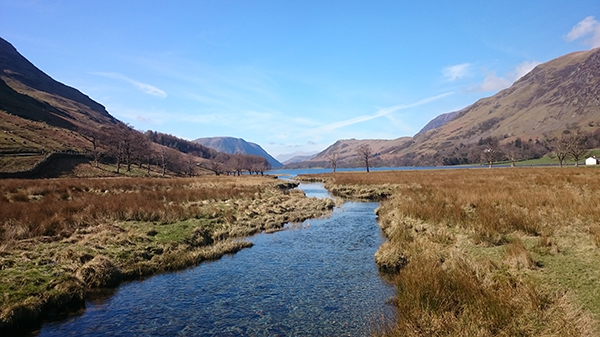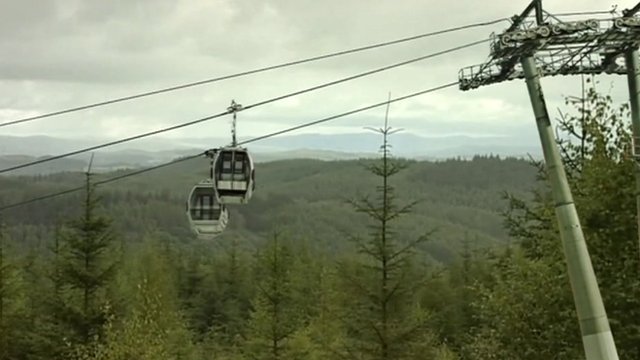Guest post by Ross Edgar.

Lake District in North West England. Image by Ross Edgar.
Cable Propelled Transit (CPT) is well established as the mode of transport of preference in ski resorts, and the use of CPT is becoming increasingly common in a mountainous setting for summer tourist activities (as discussed here and here). In addition, the profile of CPT is ever increasing as a means of mass transit within an urban environment. But what about the use of CPT for mass transit within a rural environment?
The concept in itself is not original. There are numerous examples in the Alps of small villages high up in the mountains, connected to larger towns in the valley below by a gondola or an aerial tram. But such cable systems are usually located in an area which combines a high tourist volume, access to winter and/or summer activities and a mountain environment. If any of these facets are removed, the number of examples of existing cable systems soon dwindles.
There has been very little consideration of CPT outside the two core areas described in the opening paragraph: access to tourist activities and urban transit. There are numerous scenarios outside of such applications where CPT could be of enormous benefit. For example, connecting towns and villages in a rural setting, whether tourists or mountains are involved or not, or reducing congestion on rural roads that experience high volumes of tourist traffic.
Interestingly, just such a proposal found its way into the news late last year (reported here and here). The proposal was for a gondola system in the Lake District in the north of England. The Lake District is England’s most mountainous region, is home to England’s highest mountain and is an exceptionally popular tourist destination. At present, the Lake District is not home to any cable systems; in fact, there is only one Alpine-style cable system in the entire country (the Heights of Abraham pulsed gondola in Matlock Bath, described here).
The obvious application of gondola technology in the Lake District would be to provide access to a mountain peak with the promise of a number of summer tourist activities, as tried and tested in the Alps. However, this proposal in fact suggested connecting a number of villages, which are popular tourist destinations. While the terrain along the route in question is rugged and hilly, it is not mountainous. In addition, the proposed gondola connects a number of villages rather than providing access to a specific tourist activity. The primary function of the proposal seems to be to relieve the narrow, winding rural roads in the area of the cripplingly high volumes of tourist traffic that are experienced throughout the year, while also reducing pollutant emissions.
Unfortunately, the proposal stands little chance of success. The Lake District is subject to some of the most stringent planning regulations in the country and environmental groups generally take an anti-development stance. The area faces an unenviable balancing act between protecting one of the most beautiful regions in the country and attracting the tourists that the local economy depends upon. This is particularly challenging with the prospect of losing tourism to neighbouring Scotland, which seems to enjoy less stringent planning rules in its mountainous regions and has therefore developed further as a destination for outdoor pursuits (as described here).
The problem remains for the Lake District and for other, similar areas: how to develop the area’s infrastructure to cope with the high numbers of tourists, while not over-developing the region and destroying that which attracts tourists in the first instance. CPT certainly offers a number of benefits under such circumstances over alternative transportation infrastructure, including a small land area footprint, very low noise pollution, zero local pollutant emissions (zero total if renewable energy is used) and a high hourly passenger capacity, while being unaffected by road congestion and complex scheduling, and offering an enjoyable and relaxing journey with the potential for stunning views.
Whether or not this proposal sees the light of day ever again, the underlying principle highlighted is sound: CPT is a viable means of mass transit, whether in an urban environment or a rural environment.


4 Comments
Actually a aerial tramway can be a viable option even it only transport a dozen of people per day. There are many small aerial tramways in Switzerland which are not for tourism. They are fully automatic like an elevator. Mostly there are the only connection for the people as a road winter proof would be much more expensive. In many cases they are used to transport goods.
There are some relaxed regulations for small systems to lower the cost. This is called cantonal concession. Due to this concession active marketing is not allowed but tourist can use those aerial tramways too.
For small systems gondolas have a too high capacity and are too expensive to build and operate. Also aerial tramways and funiculars can be fully automatic while gondolas need an attendant in every station.
@Matthias: Thanks for mentioning the automated aerial trams! I have actually used one or two of these in Switzerland/Austria but didn’t think to mention them in my post! As you say, for low passenger volumes, aerial trams or funiculars would be much more suited.
A Funicular requires too much infrastructure to be viable on low budget , its also possible to build a Gondola in a modular way :
– first years the services are done as an aerial tramway in an automated mode with groups of 3 o 4 MGD-10 cabins
the stations are dimensioned just on the civil engineering part (that is the cheaper part) for a standard MGD-10
– when the traffic load justifies, mount the detaching mechanism in the stations and add more cabins; line and pillars remains the same.
@GiorgioXT Thanks for your comment!